2017 HONDA CLARITY ELECTRIC snow chains
[x] Cancel search: snow chainsPage 374 of 543
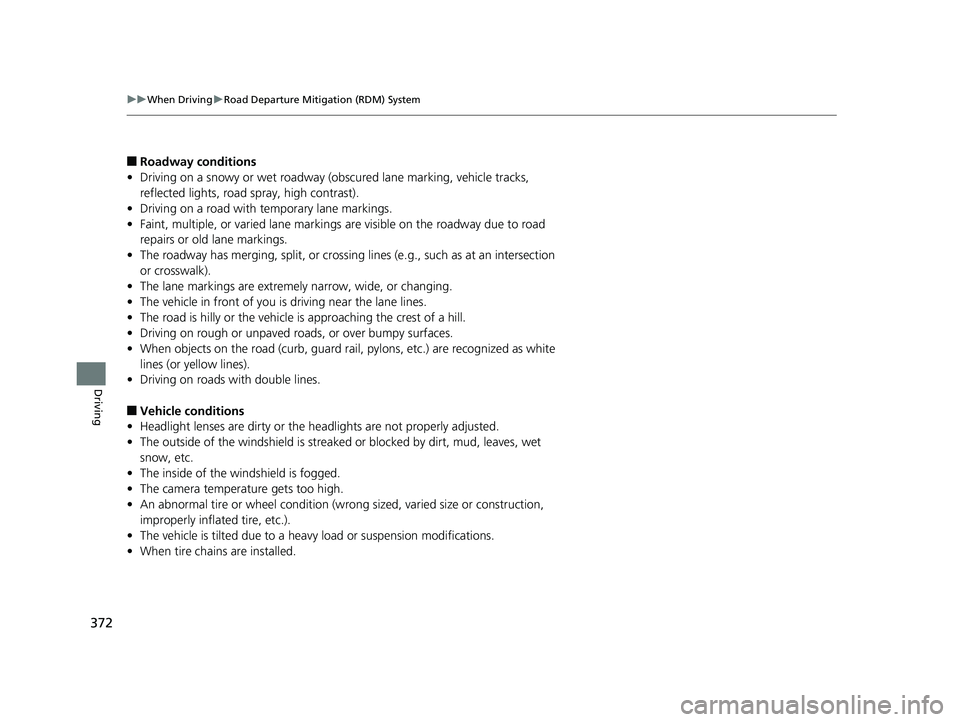
372
uuWhen Driving uRoad Departure Mitigation (RDM) System
Driving
■Roadway conditions
• Driving on a snowy or wet roadway (obscured lane marking, vehicle tracks,
reflected lights, road spray, high contrast).
• Driving on a road with temporary lane markings.
• Faint, multiple, or varied lane markings are visible on the roadway due to road
repairs or old lane markings.
• The roadway has merging, split, or crossing lines (e.g., such as at an intersection
or crosswalk).
• The lane markings are extremely narrow, wide, or changing.
• The vehicle in front of you is driving near the lane lines.
• The road is hilly or the vehicle is approaching the crest of a hill.
• Driving on rough or unpaved roads, or over bumpy surfaces.
• When objects on the road (c urb, guard rail, pylons, etc.) are recognized as white
lines (or yellow lines).
• Driving on roads with double lines.
■Vehicle conditions
• Headlight lenses are dirty or the headlights are not properly adjusted.
• The outside of the windshield is streake d or blocked by dirt, mud, leaves, wet
snow, etc.
• The inside of the windshield is fogged.
• The camera temperature gets too high.
• An abnormal tire or wheel condition (wrong sized, varied size or construction,
improperly inflated tire, etc.).
• The vehicle is tilted due to a heav y load or suspension modifications.
• When tire chains are installed.
17 CLARITY BEV CSS-31TRV6000.book 372 ページ 2017年4月14日 金曜日 午前11 時8分
Page 381 of 543
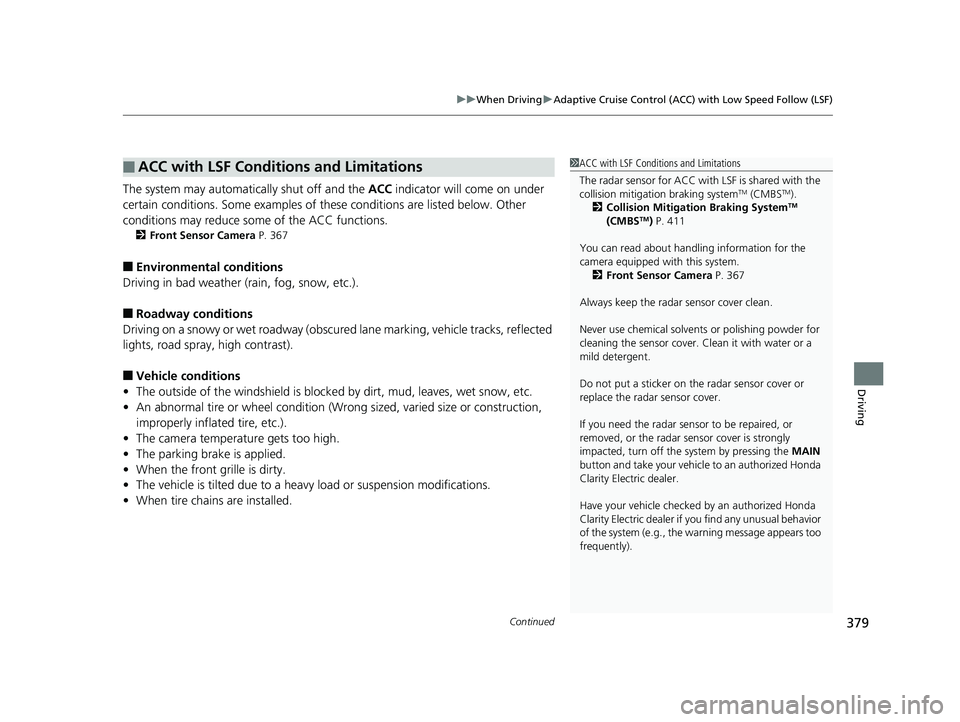
Continued379
uuWhen Driving uAdaptive Cruise Control (ACC) with Low Speed Follow (LSF)
Driving
The system may automatically shut off and the ACC indicator will come on under
certain conditions. Some examples of thes e conditions are listed below. Other
conditions may reduce some of the ACC functions.
2 Front Sensor Camera P. 367
■Environmental conditions
Driving in bad weather (r ain, fog, snow, etc.).
■Roadway conditions
Driving on a snowy or wet roadway (obscure d lane marking, vehicle tracks, reflected
lights, road spra y, high contrast).
■Vehicle conditions
• The outside of the windshield is blocked by dirt, mud, leaves, wet snow, etc.
• An abnormal tire or wheel condition (Wro ng sized, varied size or construction,
improperly inflated tire, etc.).
• The camera temperature gets too high.
• The parking brake is applied.
• When the front grille is dirty.
• The vehicle is tilted due to a heavy load or suspension modifications.
• When tire chains are installed.
■ACC with LSF Conditions and Limitations1ACC with LSF Conditions and Limitations
The radar sensor for ACC with LSF is shared with the
collision mitigation braking system
TM (CMBSTM).
2 Collision Mitigation Braking SystemTM
(CMBSTM) P. 411
You can read about handling information for the
camera equipped with this system. 2 Front Sensor Camera P. 367
Always keep the radar sensor cover clean.
Never use chemical solvents or polishing powder for
cleaning the sensor cover. Clean it with water or a
mild detergent.
Do not put a sticker on the radar sensor cover or
replace the radar sensor cover.
If you need the radar sensor to be repaired, or
removed, or the radar se nsor cover is strongly
impacted, turn off the system by pressing the MAIN
button and take your vehicl e to an authorized Honda
Clarity Electric dealer.
Have your vehicle checked by an authorized Honda
Clarity Electric dealer if you find any unusual behavior
of the system (e.g., the wa rning message appears too
frequently).
17 CLARITY BEV CSS-31TRV6000.book 379 ページ 2017年4月14日 金曜日 午前11 時8分
Page 400 of 543

398
uuWhen Driving uTire Pressure Monitoring System (TPMS)
Driving
Tire Pressure Monitoring System (TPMS)
Instead of directly measuring the pressu re in each tire, the TPMS on this vehicle
monitors and compares the rolling radius and rotational characteristics of each
wheel and tire while you are driving to determine if one or more tires are
significantly under-inflated. This will caus e the low tire pressure/TPMS indicator to
come on and a message to appear on the driver information interface.
You must start TPMS calibration every time you:
• Adjust the pressure in one or more tires.
• Rotate the tires.
• Replace one or more tires.
Before calibrating the TPMS:
• Set the cold tire pressu re in all four tires.
2Checking Tires P. 459
Make sure:
•The vehicle is at a complete stop.
• The gear position is in
(P.
• The power mode is in ON.
■TPMS Calibration
1Tire Pressure Monitoring System (TPMS)
The system does not monitor the tires when driving
at low speed.
Conditions such as low ambient temperature and
altitude change directly a ffect tire pressure and can
trigger the low tire pressure/TPMS indicator to come on.
Tire pressure checked and inflated in:
•Warm weather can beco me under-inflated in
colder weather.
•Cold weather can become over-inflated in warmer
weather.
The low tire pressure/TPMS indicator will not come
on as a result of over inflation.
The TPMS may not function pr operly if tire type and
size are mixed. Make sure to use the same size and
type of tire. 2 Checking and Maintaining Tires P. 459
The low tire pressure/TPMS indicator may come on
with a delay or may not come on at all when:
•You rapidly accelerate, decelerate, or turn the
steering wheel.
•You drive on snowy or slippery roads.•Snow chains are used.
The low tire pressure/TPMS indicator may come on
under the following conditions:
•There is a heavier and une ven load on the tires,
such as when towing a trailer, than the condition at
calibration.
•Snow chains are used.
17 CLARITY BEV CSS-31TRV6000.book 398 ページ 2017年4月14日 金曜日 午前11 時8分
Page 401 of 543
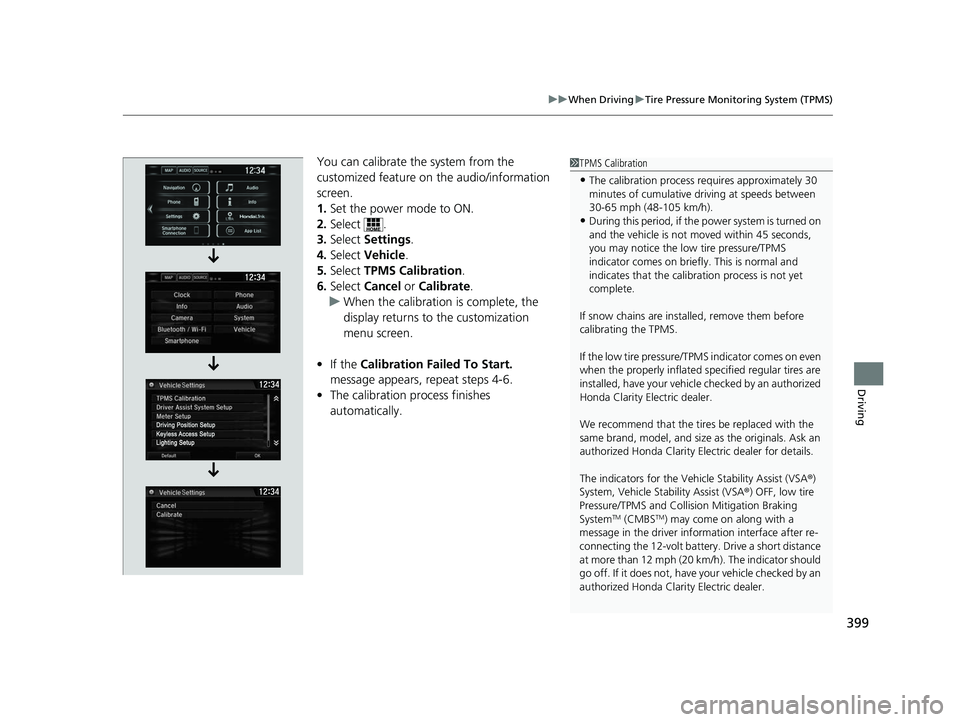
399
uuWhen Driving uTire Pressure Monitoring System (TPMS)
Driving
You can calibrate the system from the
customized feature on the audio/information
screen.
1. Set the power mode to ON.
2. Select .
3. Select Settings .
4. Select Vehicle .
5. Select TPMS Calibration .
6. Select Cancel or Calibrate .
u When the calibration is complete, the
display returns to the customization
menu screen.
• If the Calibration Failed To Start.
message appears, repeat steps 4-6.
• The calibration process finishes
automatically.1TPMS Calibration
•The calibration process requires approximately 30
minutes of cumulative dr iving at speeds between
30-65 mph (48-105 km/h).
•During this period, if the power system is turned on
and the vehicle is not moved within 45 seconds,
you may notice the low tire pressure/TPMS
indicator comes on briefl y. This is normal and
indicates that the calibr ation process is not yet
complete.
If snow chains are instal led, remove them before
calibrating the TPMS.
If the low tire pressure/TPMS indicator comes on even
when the properly inflated specified regular tires are
installed, have your vehicl e checked by an authorized
Honda Clarity Electric dealer.
We recommend that the tires be replaced with the
same brand, model, and size as the originals. Ask an
authorized Honda Clarity El ectric dealer for details.
The indicators for the Vehicle Stability Assist (VSA ®)
System, Vehicle Stability Assist (VSA ®) OFF, low tire
Pressure/TPMS and Collision Mitigation Braking
System
TM (CMBSTM) may come on along with a
message in the driver information interface after re-
connecting the 12-volt battery. Drive a short distance
at more than 12 mph (20 km/h). The indicator should
go off. If it does not, have your vehicle checked by an
authorized Honda Clarity Electric dealer.
17 CLARITY BEV CSS-31TRV6000.book 399 ページ 2017年4月14日 金曜日 午前11 時8分
Page 411 of 543
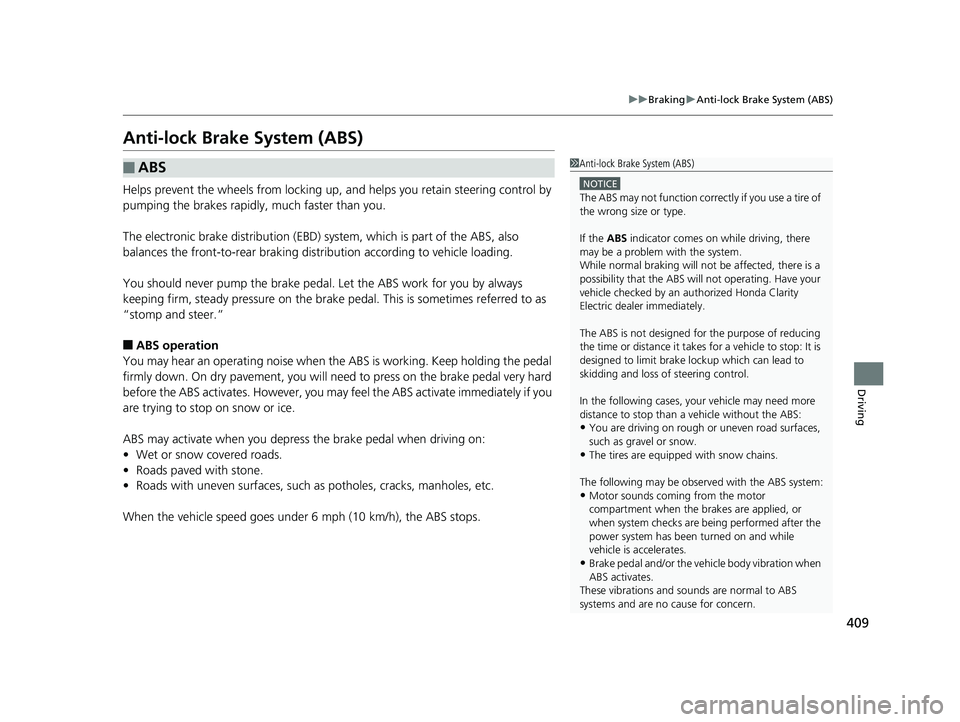
409
uuBraking uAnti-lock Brake System (ABS)
Driving
Anti-lock Brake System (ABS)
Helps prevent the wheels from locking up, and helps you retain steering control by
pumping the brakes rapidly, much faster than you.
The electronic brake distribu tion (EBD) system, which is part of the ABS, also
balances the front-to-rear braking distribution according to vehicle loading.
You should never pu mp the brake pedal. Let the ABS work for you by always
keeping firm, steady pressure on the brake pe dal. This is sometimes referred to as
“stomp and steer.”
■ABS operation
You may hear an operating noise when the ABS is working. Keep holding the pedal
firmly down. On dry pavement, you will ne ed to press on the brake pedal very hard
before the ABS activates. Ho wever, you may feel the ABS activate immediately if you
are trying to stop on snow or ice.
ABS may activate when you depres s the brake pedal when driving on:
• Wet or snow covered roads.
• Roads paved with stone.
• Roads with uneven surf aces, such as potholes, cracks, manholes, etc.
When the vehicle speed goes unde r 6 mph (10 km/h), the ABS stops.
■ABS1Anti-lock Brake System (ABS)
NOTICE
The ABS may not function correc tly if you use a tire of
the wrong size or type.
If the ABS indicator comes on while driving, there
may be a problem with the system.
While normal braking will not be affected, there is a
possibility that the ABS will not operating. Have your
vehicle checked by an authorized Honda Clarity
Electric dealer immediately.
The ABS is not designed for the purpose of reducing
the time or distance it takes for a vehicle to stop: It is
designed to limit brake lockup which can lead to
skidding and loss of steering control.
In the following cases, yo ur vehicle may need more
distance to stop than a vehicle without the ABS:
•You are driving on rough or uneven road surfaces,
such as gravel or snow.
•The tires are equipped with snow chains.
The following may be observed with the ABS system:
•Motor sounds coming from the motor
compartment when the brakes are applied, or
when system checks are being performed after the
power system has been turned on and while
vehicle is accelerates.
•Brake pedal and/or the ve hicle body vibration when
ABS activates.
These vibrations and sou nds are normal to ABS
systems and are no cause for concern.
17 CLARITY BEV CSS-31TRV6000.book 409 ページ 2017年4月14日 金曜日 午前11 時8分
Page 418 of 543
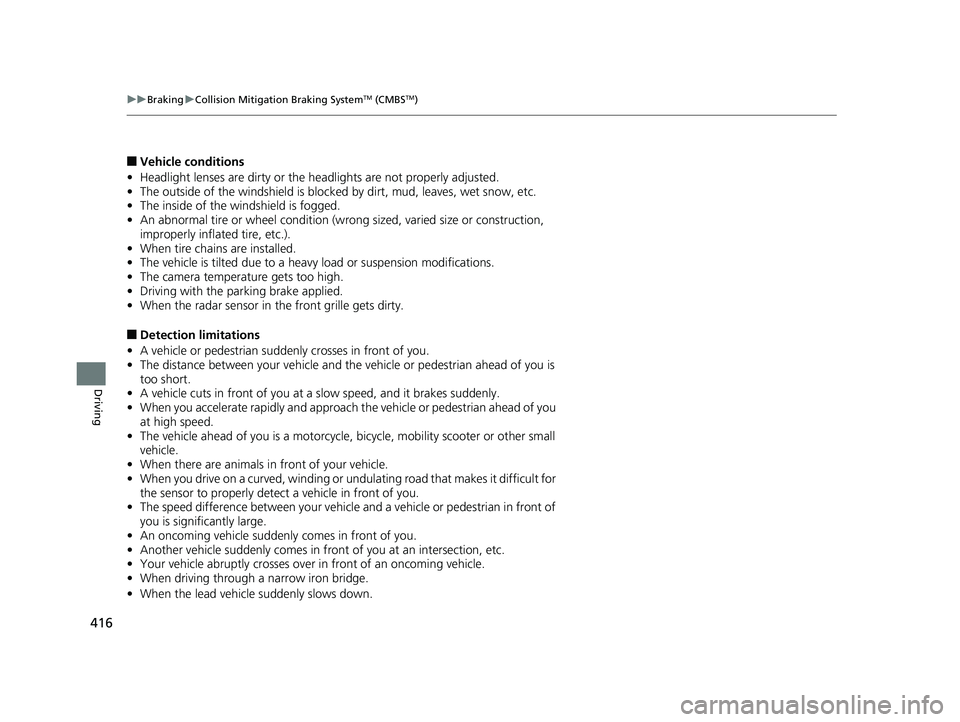
416
uuBraking uCollision Mitigation Braking SystemTM (CMBSTM)
Driving
■Vehicle conditions
• Headlight lenses are dirty or the headlights are not properly adjusted.
• The outside of the windshie ld is blocked by dirt, mud, leaves, wet snow, etc.
• The inside of the windshield is fogged.
• An abnormal tire or wheel condition (wrong sized, varied size or construction,
improperly inflated tire, etc.).
• When tire chains are installed.
• The vehicle is tilted due to a heav y load or suspension modifications.
• The camera temperature gets too high.
• Driving with the parking brake applied.
• When the radar sensor in the front grille gets dirty.
■Detection limitations
• A vehicle or pedestrian suddenly crosses in front of you.
• The distance between your vehicle and the vehicle or pedestrian ahead of you is
too short.
• A vehicle cuts in front of you at a slow speed, and it brakes suddenly.
• When you accelerate rapidly and approach the vehicle or pedestrian ahead of you
at high speed.
• The vehicle ahead of you is a motorcycle, bicycle, mobility scooter or other small
vehicle.
• When there are animals in front of your vehicle.
• When you drive on a cu rved, winding or undulating road that makes it difficult for
the sensor to properly detect a vehicle in front of you.
• The speed difference between your vehicle an d a vehicle or pedestrian in front of
you is significantly large.
• An oncoming vehicle suddenly comes in front of you.
• Another vehicle suddenly comes in front of you at an intersection, etc.
• Your vehicle abruptly crosses over in front of an oncoming vehicle.
• When driving through a narrow iron bridge.
• When the lead vehicle suddenly slows down.
17 CLARITY BEV CSS-31TRV6000.book 416 ページ 2017年4月14日 金曜日 午前11 時8分
Page 469 of 543
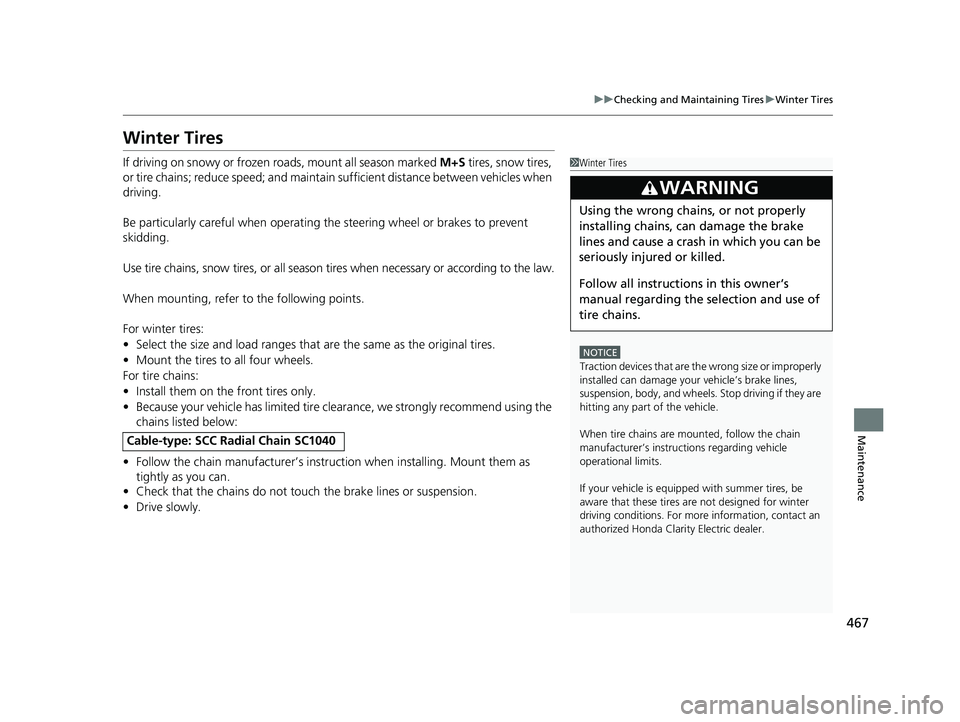
467
uuChecking and Maintaining Tires uWinter Tires
Maintenance
Winter Tires
If driving on snowy or frozen roads, mount all season marked M+S tires, snow tires,
or tire chains; reduce speed; and maintain sufficient distance between vehicles when
driving.
Be particularly careful wh en operating the steering wheel or brakes to prevent
skidding.
Use tire chains, snow tires, or all season tires when necessary or according to the law.
When mounting, refer to the following points.
For winter tires:
• Select the size and load ranges that are the same as the original tires.
• Mount the tires to all four wheels.
For tire chains:
• Install them on the front tires only.
• Because your vehicle has limited tire clea rance, we strongly recommend using the
chains listed below:
• Follow the chain manufactur er’s instruction when installing. Mount them as
tightly as you can.
• Check that the chains do not touch the brake lines or suspension.
• Drive slowly.
Cable-type: SCC Radial Chain SC1040
1Winter Tires
NOTICE
Traction devices that are th e wrong size or improperly
installed can damage your vehicle’s brake lines,
suspension, body, and wheels. Stop driving if they are
hitting any part of the vehicle.
When tire chains are mounted, follow the chain
manufacturer’s instructi ons regarding vehicle
operational limits.
If your vehicle is equipped with summer tires, be
aware that these tires are not designed for winter
driving conditions. For more information, contact an
authorized Honda Clarity Electric dealer.
3WARNING
Using the wrong chains, or not properly
installing chains, can damage the brake
lines and cause a crash in which you can be
seriously injured or killed.
Follow all instruction s in this owner’s
manual regarding the selection and use of
tire chains.
17 CLARITY BEV CSS-31TRV6000.book 467 ページ 2017年4月14日 金曜日 午前11 時8分
Page 538 of 543
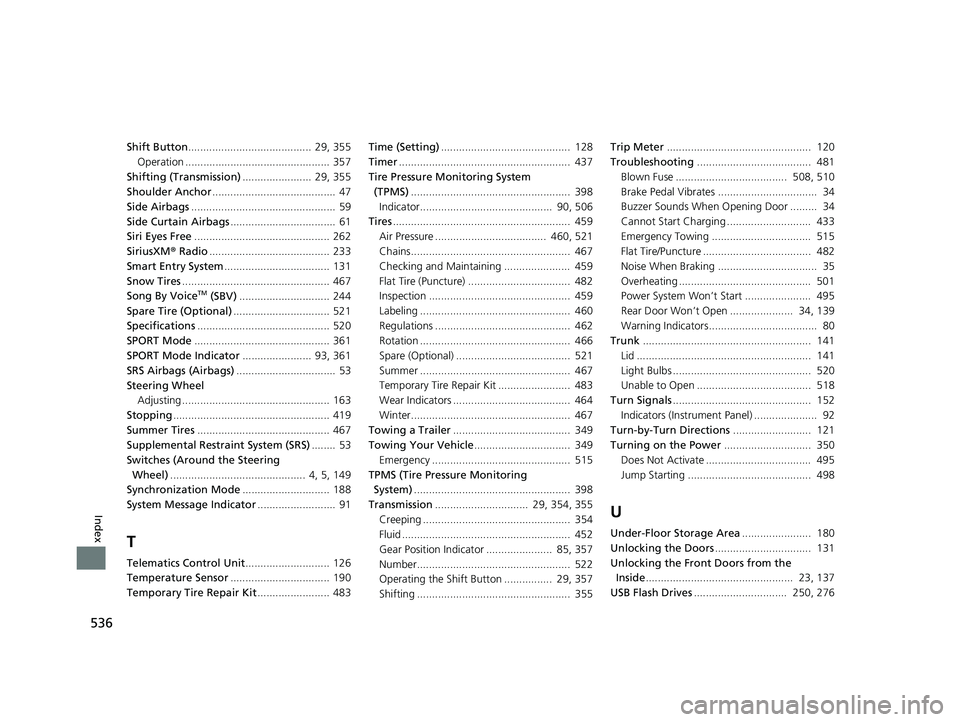
536
Index
Shift Button......................................... 29, 355Operation ................................................ 357
Shifting (Transmission) ....................... 29, 355
Shoulder Anchor ......................................... 47
Side Airbags ................................................ 59
Side Curtain Airbags ................................... 61
Siri Eyes Free ............................................. 262
SiriusXM ® Radio ........................................ 233
Smart Entry System ................................... 131
Snow Tires ................................................. 467
Song By Voice
TM (SBV) .............................. 244
Spare Tire (Optional) ................................ 521
Specifications ............................................ 520
SPORT Mode ............................................. 361
SPORT Mode Indicator ....................... 93, 361
SRS Airbags (Airbags) ................................. 53
Steering Wheel
Adjusting ................................................. 163
Stopping .................................................... 419
Summer Tires ............................................ 467
Supplemental Restraint System (SRS) ........ 53
Switches (Around the Steering
Wheel) ............................................. 4, 5, 149
Synchronization Mode ............................. 188
System Message Indicator .......................... 91
T
Telematics Control Unit............................ 126
Temperature Sensor ................................. 190
Temporary Tire Repair Kit ........................ 483Time (Setting)
........................................... 128
Timer ......................................................... 437
Tire Pressure Monitoring System (TPMS) ..................................................... 398
Indicator............................................ 90, 506
Tires ........................................................... 459
Air Pressure ..................................... 460, 521
Chains..................................................... 467
Checking and Maintaining ...................... 459
Flat Tire (Puncture) .................................. 482
Inspection ............................................... 459
Labeling .................................................. 460
Regulations ............................................. 462
Rotation .................................................. 466
Spare (Optional) ...................................... 521
Summer .................................................. 467
Temporary Tire Re pair Kit ........................ 483
Wear Indicators ....................................... 464
Winter..................................................... 467
Towing a Trailer ....................................... 349
Towing Your Vehicle ................................ 349
Emergency .............................................. 515
TPMS (Tire Pressure Monitoring System) .................................................... 398
Transmission ............................... 29, 354, 355
Creeping ................................................. 354
Fluid ........................................................ 452
Gear Position Indicator ...................... 85, 357
Number................................................... 522
Operating the Shift Button ................ 29, 357
Shifting ................................................... 355 Trip Meter
................................................ 120
Troubleshooting ...................................... 481
Blown Fuse ..................................... 508, 510
Brake Pedal Vibrates ................................. 34
Buzzer Sounds When Opening Door ......... 34
Cannot Start Charging ............................ 433
Emergency Towing ................................. 515
Flat Tire/Puncture .................................... 482
Noise When Braking ................................. 35
Overheating ............................................ 501
Power System Won’t Start ...................... 495
Rear Door Won’t Open ..................... 34, 139
Warning Indicators.................................... 80
Trunk ........................................................ 141
Lid .......................................................... 141
Light Bulbs .............................................. 520
Unable to Open ...................................... 518
Turn Signals .............................................. 152
Indicators (Instru ment Panel) ..................... 92
Turn-by-Turn Directions .......................... 121
Turning on the Power ............................. 350
Does Not Activate ................................... 495
Jump Starting ......................................... 498
U
Under-Floor Storage Area ....................... 180
Unlocking the Doors ................................ 131
Unlocking the Fron t Doors from the
Inside ................................................. 23, 137
USB Flash Drives ............................... 250, 276
17 CLARITY BEV CSS-31TRV6000.book 536 ページ 2017年4月14日 金曜日 午前11 時8分